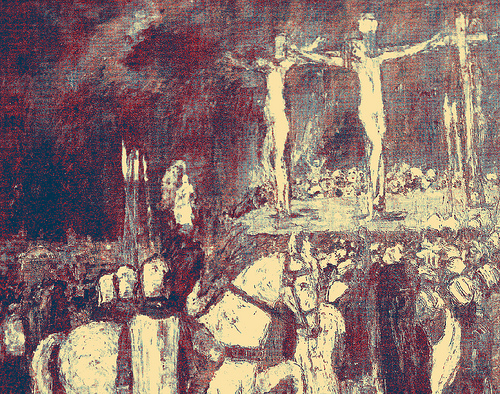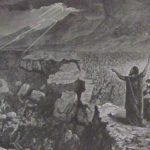We run our website the way we wished the whole internet worked: we provide high quality original content with no ads. We are funded solely by your direct support. Please consider supporting this project.

The Greatest Mystery of the Christian Faith
God has always been willing to stoop to accommodate the fallen state of his covenant people in order to remain in a transforming relationship with them and in order to continue to further his sovereign purposes through them.
Out of love for humankind, Scripture tells us, Jesus emptied himself of his divine prerogatives, set aside the glory he had with the Father from before the foundation of the world, became a human being and bore our sin as he died a God-forsaken death on Calvary (Phil 2:5-7; 2 Cor 5:21). Though Jesus remained fully God, he entered into total solidary with humanity by becoming a full human being. And though Jesus remained sinless, he entered into total solidarity with our sin and condemnation, to the point that Paul boldly proclaimed that Christ in some real sense became our sin and became our curse (2 Cor 5:21). The cross, which is the culminating expression of the meaning of the Incarnation and everything else Jesus was about, reveals a God of covenantal love who is not above setting aside his glory to accommodate the limitations and sin of his fallen people.
So too, the cross reveals a God of unfathomable humility and mercy who is not above stooping to appear far less beautiful than he actually is—to appear as a guilty, crucified criminal!—in order to save us and to continue to achieve his sovereign purposes through his covenant people. It thus reveals a God who out of love is willing to condescend to appear in ways that reflect more of the sin of his people than they reflect the way he actually is, thereby disclosing his sin-bearing character. The incomprehensibly humble, self-sacrificial love displayed on the cross reflects the character of God’s very essence (hupostasis, Heb. 1:3) as well as the way God has always been relating to, and working through, his covenant people. This is what I call The Principle of Cruciform Accommodation.
Reflecting on the revelation of the crucified God leads us to the most profound, beautiful, and important mystery of the Christian faith. The fullest and clearest revelation of God’s true nature took place precisely when God stooped to take on a semblance that is antithetical to his true nature. What could be more antithetical to the all-holy God than to, in some sense, become our sin (2 Cor. 5:21)? While this revelation of course never ceases to be wonderfully mysterious, I believe it can be rendered intelligible, but only when we accept that God’s eternal nature is a union of three divine Persons who eternally give themselves wholly to one another in perfect, humble, self-giving love.
As Father, Son and Holy Spirit, God is from all eternity a self-giving God who pours himself out for “another.” Indeed, this is not only something the three Persons of the Trinity do; this is who the triune God eternally is. I concur with Torrance when he argues that, “the atoning act perfected in the cross of Jesus Christ is grounded in the very being of the eternal God, that is, in the eternal being of the Holy Trinity.” This, I contend, is the meaning of the revelation that God is love—the kind of love that is revealed when God stoops to the infinite extreme of becoming a human and dying on a cross for a race of people who could not deserve it less (I Jn 4:8; 3:16).
The revelation of the Trinity renders the revelation of God on the cross intelligible because it means that when God humbly poured himself out on behalf of humanity by stooping to the furthest extreme possible—viz. by fully identifying with our humanity, our sin, and our judgment—he was not doing something foreign to himself. To the contrary, by stooping in this way, the eternal triune God was simply enveloping humans into the self-giving, triune, love that he eternally is. As paradoxical as it sounds, when God the Son stooped to the infinite extremity of experiencing God-forsakenness on the cross, he was manifesting outwardly in time the perfect unity he eternally enjoys with the Father.
Only by understanding the perfect unity of self-giving Trinitarian love can we simultaneously affirm the unbroken, ongoing unity of the person and actions of Jesus and the Father, on the one hand, while affirming the authenticity of Christ’s cry, “Eli, Eli, lama sabachthani,” on the other.
If we affirm any other sort of unity, then Jesus’ entrance into the God-forsakenness of our sin and bondage to the devil would undermine the unity of the Trinity and thereby virtually destroy the Godhead! Once we understand the divine unity to be other-oriented love, however, then Jesus’ forsakenness can be understood as expressing, rather than undermining, the infinite intensity of this unity, for there could be no greater expression of other-oriented love than this.
Because God’s true eternal nature is a perfect, other-oriented, self-giving fellowship of three divine persons, we can render intelligible the paradoxical claim that God is revealed by becoming something that is not only different from himself (a human being), but that is even utterly antithetical to himself (our sin and God-forsakenness). The infinite intensity of the perfect love that is the eternal character of the triune God is revealed in the fact that God condescended to the furthest extreme possible—viz. into his own self-negation—out of love for a race of rebels who wanted only to crucify him. The revelation is the condescension. Hence, the most extreme condescension possible constitutes the most perfect revelation possible.
Image by Cea. via Flickr.
Category: General
Tags: Cross, Cruciform Theology, Incarnation, Love, Self-Sacrificial Love, Trinity
Related Reading

Four Principles of the Cruciform Thesis
In the second volume of Crucifixion of the Warrior God, I introduce how four dimensions of the revelation of God on the cross (as introduced in this post) lead to four principles that show us how to unlock aspects of the OT’s violent divine portraits and thus disclose how a given portrait bears witness to…

Loving Enemies in the Day of ISIS
The following excerpt from Myth of a Christian Religion discusses Jesus’ command to “turn the other cheek.” Whatever our response to the persecution of Christians in the world, we must take this passage seriously. While this excerpt does not tell us exactly how to respond, it can be used to shape our attitude and stance…

Confronting the Divine Montage
The superiority of Jesus’ revelation over a montage view of God (see previous post) is captured when Paul and the author of Hebrews utilize an analogy of a shadow verses reality. Paul instructs his disciples not to “let anyone judge you by what you eat or drink, or with regard to a religious festival, a…

A Cruciform Magic Eye
In this post I’d like to share the story of how I came upon the thesis I’m defending in the book I’ve been working on for the last four years entitled The Crucifixion of the Warrior God: A Cruciform Theological Interpretation of the Old Testament’s Violent Divine Portraits. It’s a much longer post than usual,…

Was Jesus Unloving Towards the Pharisees?
Some claim that Jesus spoke to religious leaders in ways that did not reflect the love of the cross. In his climatic encounter with the Pharisees in Matthew 23, Jesus’ words were undeniably harsh. He calls the Pharisees “hypocrites,” “blind guides,” “blind fools,” “snakes” and “a brood of vipers” (Mt 23:13, 15, 16,17, 19, 23,…

Willing to Bleed
What does salvation have to do with social justice? Greg turns this often-politicized question on its head in this video by The Work of the People.
